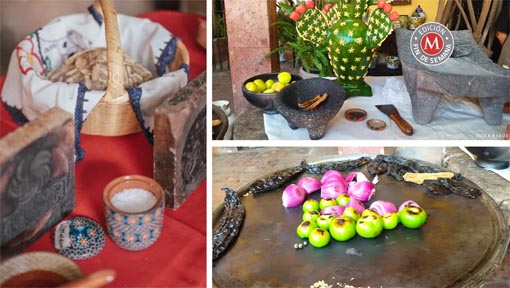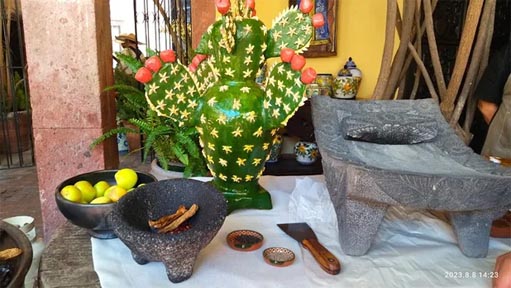They rescue tradition of Mexican gastronomy
News Category: News and Food and Drink
-
Published September 9, 2023
Ceremonial tortillas, salsa borracha, mixiotes and pulque are part of the experience at the Cielito Lindo restaurant in San Miguel de Allende, which applies the techniques of molcajete and metate in its preparation.
Surrounded by Mexican crafts, such as vases, molcajetes and xoloscuintles dogs reproduced in clay and stone, the Cielito lindo restaurant outdoors, inside the Hacienda El Santuario hotel; becomes ideal for the experience that seeks to “rescue the traditions of Mexican food”.
Chef Carlos Serrano is the host and who explains what the experience consists of: “The idea is that they know the main techniques that distinguish our cuisine, and that are executed with the molcajete and the metate, but that they not only know them, but also practice them”.
The first step in the experience is to learn the tradition of ceremonial tortillas, so Luz María takes the floor and begins her ritual.
“First we do a ceremony with copal and rosemary to thank us for being able to make this food,” he says as he raises a censer.
And once he has divine authorization, he begins the production of tortillas with seal, custom of his community, Otuña de abajo, very close to San Miguel de Allende, and that has prevailed for years. First as a religious tradition and now as a beautiful way to celebrate so his family is dedicated to the production of wooden stamps for tortillas, with the figure that is requested at a cost of 600 pesos.
After kneading the dough, prepare the paint that you will put on the seal that you will print on your tortillas.
“For the dye we use muicle, it is a little plant that gives us the color, it is green, but when boiled it is like icing.”
Once it has the necessary ingredients, the preparation of the tortilla begins and from the first one that it throws to the comal the mastery of the technique is appreciated.
“I started when I was a child, so it’s already something very easy for me,” although she recognizes that sometimes she gets hit on the comal.
And he warns that the tincture with the seal should be put on when the tortilla is half cooked.”
A few minutes later the tortilla is ready, then the chef proposes to enjoy it “with beans, Cotija cheese and the drunken sauce” that minutes before was prepared in the molcajete with tomatoes, onions, meco chile, pico de pájaro chile or piquín, previously tatemados over low heat and pulque that gives the distinctive flavor to the preparation.
“The molcajete is a traditional instrument of Mexican cuisine that also has its technique and that there are 3 or 2 legs or even without legs. And the force must be printed on the tejolotl so that the tomatoes or chilies are ground and not only the stone is hit,” explains the chef
And he recommends “in the town of Comonfort, which is on the way to Celaya, they find various sizes and decorations, there are birds, rams, of all kinds.”
The time to know the technique of metate occurs when you have to grind the chilies for the marinade that the mixiotes will take to prepare. The chef explains how to place the ingredients, how to grab the molote (the stone with which they are ground) and how the friction movement between both stones should be to achieve the pasta from the chilies and spices that will be transformed into the marinade. He even recognizes that tradition dictates that the action must be executed on one’s knees to drop the force when grinding.
And once the marinade is ready, the mixiote is prepared, while as an appetizer the chef proposes a jug of honey water that Don Nacho and his son supply to the restaurant, as well as the pulque with which the drunken sauce was prepared.
“The intention is to make collaborations with the communities near San Miguel, so, just as Luz supports us with the Ceremonial Tortillas, Don Nacho brings us honey water and pulque, in this way we preserve the traditions and we can offer experiences very of our culture to our visitors or guests, “explains the chef.
By then a cheese arrives at the table to accompany the honey water; while Don Nacho explains the process of extracting pulque and how he “cures” it, in addition to all the benefits of the drink of the gods.
“We scrape the maguey for the pulque preparation. And we have to have a cured clay pot, where we will place the drink with the honey water and let it ferment and after about five days it is ready to enjoy, “he says.
And he also highlights the benefits of the drink that gives the maguey: “Honey water is rich in nutrients, very good for anemia and much better than a serum, while pulque is a great probiotic,” he says just when the mixiote arrives at the table and next to it a jar of pulque to achieve the ideal pairing. ”
“The idea of this pairing is to remove the taboos of honey water and pulque and show that it is a perfect combination for our Mexican dishes,” says the chef, who to close the experience offers a rich corn bread with a cured garambullo (cactus fruit).
*The traditional cooking class is one of the experiences offered by La Hacienda El Santuario to its guests or visitors to the Cielito lindo restaurant.
* The ceremonial tortilla workshop can be enjoyed on weekends at the restaurant’s brunch in San Miguel de Allende.
Hotel Hacienda El Santuario ostenta los siguientes distintivos y reconocimientos: CLUB DE CALIDAD TESOROS, DISTINTIVO M, GRAN ANFITRIÓN, también forma parte de la Red NEW ADVENTURES quien nos reconoce como una de las 100 mejores empresas en México socialmente y ecológicamente responsables, también la REVISTA TRAVESÍAS nos menciona como uno de los 25 Hoteles ECO-CHIC de México.




Leave a Reply